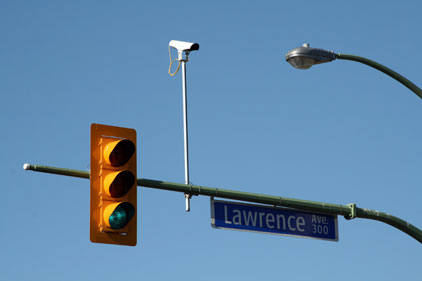In 1991, the U.S. Congress established a federal program to develop and test Intelligent Transportation Systems (ITS) and promote their implementation. The ITS program explores ways that information and technology can improve transportation safety. Since the early 1990s, the federal government has earmarked dollars for cities across the United States to put technology in place to manage traffic and protect public safety. Tuscaloosa, Alabama, is one city that has benefitted.
The Tuscaloosa Department of Transportation received federal funding for traffic message boards as well as cameras, which have helped the city manage its traffic without widening its roads. The program was the Tuscaloosa Transportation Department’s entry to cameras.
Using its bucket trucks and technicians, Tuscaloosa’s DOT began installing cameras at high-volume intersections across the city. Eventually, every major intersection in Tuscaloosa had a DOT-installed camera in place.
“We’re not camera people, but we’ve become camera people through experience,” says Chris Golden, Tuscaloosa Department of Transportation.
As cameras transitioned to Ethernet and IP, Tuscaloosa’s transportation department says it had to switch from running coaxial cable to programming each camera, assigning an IP address and ensuring it fit into the overall network IP scheme. Golden and his colleagues began focusing on installation and programming of cameras, wireless equipment and Ethernet switches.
Putting its Experience to Work for Hope
In July 2008, Tuscaloosa Mayor Walt Maddox announced the Hope Initiative, which was to be the start of a long-term effort to fight crime in his city. Maddox’s Hope Initiative included a number of recommendations such as increasing patrols by police, establishing an East Tuscaloosa police precinct and making infrastructure improvements such as adding security cameras. Since the Tuscaloosa Transportation Department had the equipment and experience installing cameras as part of the ITS initiative, the city turned to its DOT to install cameras for the Hope Initiative.
As the DOT team had already taught themselves how to install and format red-light cameras and other traffic-based surveillance devices, the installation of more involved surveillance devices was less of a drastic learning curve, while saving money for the department, Golden tells Security.
The transportation department worked with its integrator to lay out a scheme for the Hope Initiative security systems, basing it around servers and software platform options.
The City of Tuscaloosa funded a portion of the Hope Initiative and the University of Alabama added dollars, too. The University of Alabama sits adjacent to some of the areas Maddox’s Hope Initiative is focused on. According to Golden, a main focal area for the Hope Initiative is the “Strip,” which includes university student housing. Among the goals of the Hope Initiative was giving peace of mind to residents as well as parents whose children were attending the university, sometimes, a long way from home.
“The Strip is an area we’re continuing to install cameras in,” adds Golden.
The Hope Initiative’s cameras began to come online in early 2009, says Golden. There were very few stable security center platforms available when the city kicked off its Hope Initiative, he says. However, new platforms offer more reliable and flexible options.
The city’s current VMS platform has been in place for four years. And even through regularly scheduled swaps of PCs, the system continues to perform. For example, even in cases where the DOT’s security desk client application loses connectivity to its servers, the city can continue monitoring cameras and maintain access to live video.
Through the program, the Tuscaloosa Police Department and other first responders can view footage of seven Hope Zones across the city; the system stores the footage for up to two weeks. And the police IT department can assign who has access to which footage. The city’s DOT also has access to the camera footage, but its goal is not observing people. Rather, the DOT monitors only the real-time footage to make sure the cameras are operating correctly day and night. The University of Alabama can also see approved video footage and share it with the school’s engineering lab to use for research.
Installing Hope Cameras
“We had steered clear of wireless products, except for a few areas, because we always thought fiber was better,” remarks Golden. However, after testing multiple versions of wireless cameras, he was pleasantly surprised with the lack of latency.
After six months of use and testing, the Tuscaloosa DOT decided the wireless cameras would work for the Hope Initiative as well as elsewhere. For example, the DOT is testing out a wireless surveillance system at the Tuscaloosa airport. The airport has cameras connected by fiber, which run back to the DOT compound. But there were areas that DOT wanted to monitor that were impossible to reach with fiber. So Golden and his team installed the camera system and receivers and transmitters up to a half mile from one another. The system performed flawlessly, he says.
“There is some latency in the mobile camera system, but it’s not like the old 30-frames per second,” remarks Golden.
“We had an air show with the Blue Angels, and we used mobile cameras for monitoring crowds, moving people from shuttle buses,” he says. “The image is as close to real time for an aircard as you could ever imagine. The cameras are 3G, and you band them to a pole and move it to the next pole if and when needed.”
Seventy-five percent of Tuscaloosa is covered by Hope cameras. In fact, most city property has Hope cameras. According to city officials, there are some buildings such as the city courthouse or parking garage that have a different camera system with its own protocol, but the city’s leaders hope to move these outliers to the Hope system.
“There is no end-date for this project,” Golden tells Security. “It’s likely that we’ll keep adding to it and working on it forever.”
“The beauty of (our) IP video management system is that so many different types of cameras and Ethernet products work with it,” adds Golden. “We have eight camera systems as part of the Hope initiative.”
While there are a lot of cities that have extensive security systems in place, Golden believes Tuscaloosa is unique because it doesn’t rely on contractors as the primary operators. “We do 90 percent of the installation and monitoring work ourselves, and we get assistance from our contractors when we need an expert opinion,” he says.
Curbing Crime with Cameras
In 2009, the Hope Initiative saw crime in the city’s Rosedale Hope Zone, where 11 percent of the city’s crime occurred in 2008, drop by 20 percent. Officials say the camera system played a role as well as added police patrols, the new police precinct and the involvement of more than 60 churches and various social service groups. On April 27, 2011, a major tornado destroyed many areas in Tuscaloosa covered by the Hope Initiative, so the Police Department’s public affairs office says current statistics would be skewed because of the resulting population shift.
According to city officials, keeping the Hope Initiative on track requires ongoing attention, community involvement and the latest technology. To that end, the Transportation Department expects that its next project will be to add a high-definition network camera system with H.264 full line compression for monitoring additional areas within the Hope Zones as well as assets such as the city’s dam.
Original case study courtesy of Moog Inc. Additional reporting by Claire Meyer, Security associate editor.



